
When cutting a willow, success depends on the right time. The right appointment helps to prevent possible problems after the cut.
In a nutshell
- Due to the Federal Nature Conservation Act, the trees may only be cut over the winter
- the ideal cutting time for willows is February
- a cut at the beginning of winter is also possible
- moderate pruning measures are permitted over the summer
- some willow species do not need pruning at all
Cut back in spring
No matter what type of willow you cultivate, all are preferably cut at the same time. Since willows are trees and shrubs, you must observe the Federal Nature Conservation Act. This means that between March 1st and September 30th no woody plants such as willows may be cut due to bird protection reasons. This means, above all, extensive care and pruning. For this reason, cut or thin out Salis species over the winter. The appropriate cutting time in February is as follows:
 The willow should be cut back before kitten formation.
The willow should be cut back before kitten formation.
- after last winter frosts
- before new leaves emerge
- before kitten formation
Tip: In addition to pruning in February, the harlequin willow (Salix integra 'Hakuro Nishiki') should be pruned moderately from the end of June to mid-July. You should only shorten the crown a little so that it continues to sprout vigorously over the summer.
Winter pruning
An exception to the timing of pruning concerns white willows (Salix alba) and all specimens raised as pollard willows. If, for some reason, you do not have the opportunity to cut in the spring, you can postpone the measure until the beginning of winter. November is recommended, when the night-time temperatures are not too low. As with the spring cut, at least 5°C is recommended.
Notice: Before cutting, be sure to check whether animals are already overwintering in your pastures. If this is the case, you must not cut the growth until the visitors have left the winter quarters.
note the weather
It is not just the timing of cutting the willow that is important for properly pruning your Salis. You should choose a suitable day when the weather does not affect the pasture. Although they are very robust and cut-tolerant, the weather can still make them uncomfortable. The following points should be considered when choosing the day:

- dry
- no precipitation
- cloudy sky
- Frost free
frequently asked Questions
When are summer cuts allowed?Summer cuts may only be carried out if they are light cuts. A radical cut back or a classic care cut are not part of it. However, careful thinning is possible. Make sure you only remove this year's shoots. Others are not allowed.
Which pastures do not need to be cut?If you cultivate a weeping willow (Salix babylonica), you don't have to reserve a time for pruning if you prefer the natural growth form. The hanging shoots would be shortened too much with a cut. If, on the other hand, the shoots are not to become too long, the weeping manner is cut in February. She should have her hair trimmed every six to eight years.
When are wildlings removed?If you see wild shoots on your willows, you can remove them either at the normal cutting time or later, around mid-July. Wild shoots from the ground are torn out, while you cut the others right at the trunk. This care measure is permitted in the summer, since it is not an extensive cut.